Field Notes: A visitor’s experience
Policy officer Hebe Carus asks if we can learn lessons from how other countries manage visitor pressure
 There is talk of a tourist tax in Scotland - particularly the Highlands - to help combat pressures caused by the success of the North Coast 500 (NC500) route. Despite the marketing initiative delivering economic benefits to businesses on the route, there has been a reduction in facilities such as toilets and waste management in order for local authorities to save money due to tightened budgets.
There is talk of a tourist tax in Scotland - particularly the Highlands - to help combat pressures caused by the success of the North Coast 500 (NC500) route. Despite the marketing initiative delivering economic benefits to businesses on the route, there has been a reduction in facilities such as toilets and waste management in order for local authorities to save money due to tightened budgets.
In early October, we are meeting the Cabinet Secretary to discuss these issues and potential solutions to ensure boosted economies in rural Scotland do not adversely impact on the very wildness that attracts many visitors. Meanwhile, how do our European neighbours cope with similar pressures on their wild areas? This year I threw myself in at the deep end to find out.
Despite, never having undertaken a multi-day, feet-based, expedition I took on what is tagged as the 'toughest' Grand Randonnee (GR) in Europe. GRs are the French subset of European-wide network of long distance routes. The GR20 cuts north-west to north-east across the island of Corsica with the wildest and roughest section being the north section with 8,700m altitude gain with only slightly less height loss, and a distance of 113km over nine days. There is scrambling over slabs, scree slopes and boulder almost all the way through the wild heart of the Regional Natural Park of Corsica – it is definitely rough and tough. The GR20 is the flagship of the tourist offer in central Corsica and is a major contributor to the economy of the island interior.
The landscape and scenery was truly spectacular with a strong sense of wildness and apparently primary forests dominated by pine, beech and alder beneath the spectacularly craggy peaks. However, the visitor experience was not quite what I expected.
The dispersed network of mountain refuges are the only locations you can legally camp (some have bed bugs so I opted to camp), and these are the only locations in the main mountain areas with toilet and waste facilities. I went in September – promoted as a quieter time of year, but before facilities start to close in the middle to end of the month which would have necessitated carrying all necessary food in and waste out.
The experience was one of wild landscapes through the day, but every afternoon arriving at a refuge to book a campsite and find they are sold on demand rather than according to capacity (most refuges are on steep rocky hillsides with often minimal flat areas and these only where water has pooled after the regular heavy storms).
At many overnight locations there were over 20 or 30 tents with two toilets (and at one refuge only one – you can imagine the consequences of that!) Many of the other trekkers I met reported the same impression of stunning landscapes and experience through the day, but tolerating the situation every night – leaving mixed feelings about the GR20.
My experience naturally led me to think about parallels with the visitor pressure and rural economy discussions back home in Scotland and I will leave you with some questions to ponder.
- Where does the quality of the experience get calculated in the drive for economic growth? Is a blunt instrument assessment of benefit like tourist spend reflective of the benefits, and how is this balanced against the intangible costs to the quality of the experience where facilities do not keep pace? Many people on the GR20 will never return, but the marketing of Scotland maybe different.
- Many businesses benefit from visitor marketing, but that does not always spread across the local community that may experience impacts – how do we manage that? There were rumours that some refuges are burned down to divert the route to other businesses as the benefits are so locally experienced. We are not quite in that situation in the UK, but benefits need to compensate local communities for the costs like hugely increased traffic and impacts on their local environment.
- Maybe it doesn’t matter if visitors move through an area quickly only taking selfies? If it does, how do we promote “slow tourism”? Would this increase the appreciation and support for wildness and translate into greater conservation? The GR20 forces slow tourism through remoteness from roads, but elsewhere this is a change that has been reported by local communities, especially in rural Scotland along the NC500.
- Investment in rural areas needs demand that generates income (the theory behind a tourist tax), or should we not try to heavily market an experience without being sure we have the facilities that will be needed (or funds to do so keeping pace with demand) – do we invest before the income starts rolling in, or the other way about? Is there a disconnect between the significant income of the GR20 refuges and investment in facilities? Tightened Council budgets have recently closed a significant proportion of toilet facilities in the Highlands of Scotland, with resulting impacts for communities, and other visitors – is a tourist tax a solution?
Photo at the top by Keith Salton shows the Trust's new sign aimed at visitors to Droman near Sandwood Bay on Scotland's popular NC500 route.

